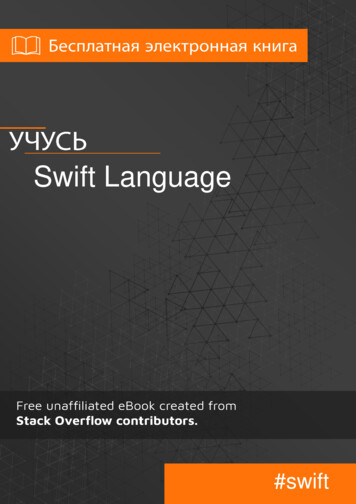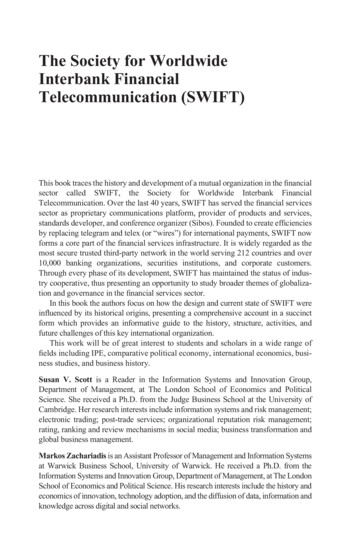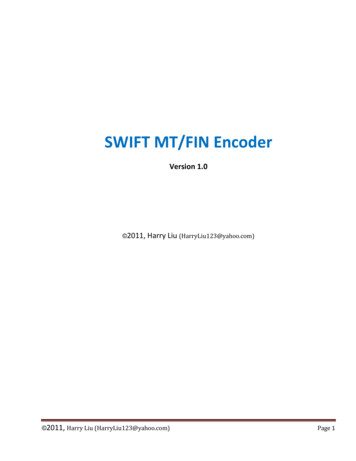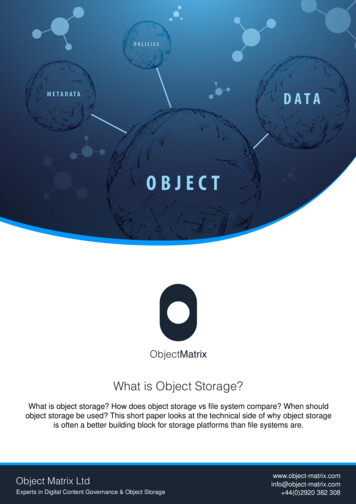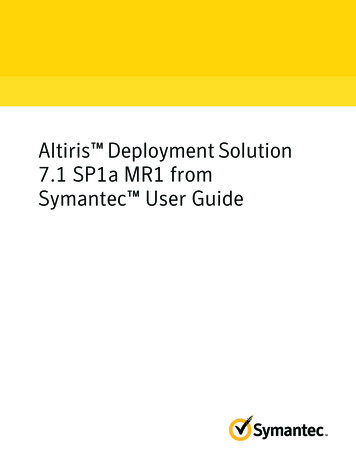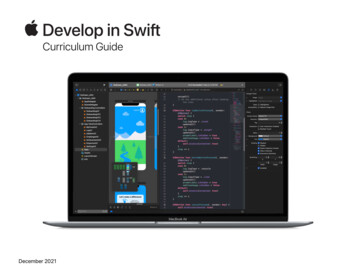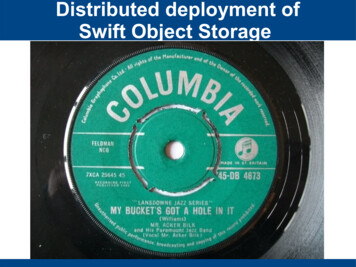
Transcription
Distributed deployment ofSwift Object Storage Istituto Nazionale di Fisica Nucleare
Distributed deployment ofSwift Object Storage'Cause My Bucket's Got A Hole In ItYeah! My Bucket's Got A Hole In ItYeah! My Bucket's Got A Hole In ItI can't buy no beer. Istituto Nazionale di Fisica Nucleare
Contents Object Storage Swift Object Storage Geographically distributed Swift deployments Use cases19.12.14Stefano Stalio3
Object Storage Object Storage is a storage architecture that manages data asobjects, as opposed to other storage architectures like filesystems which manage data as a file hierarchy and blockstorage which manages data as blocks within sectors andtracks.Each object typically includes the data itself, a variable amountof metadata, and a globally unique identifier.19.12.14Stefano Stalio4
Object Storage /2 Object storage can be implemented at multiple levels, includingthe device level (object storage device), the system level, and theinterface level.In each case, object storage seeks to enable capabilities notaddressed by other storage architectures, like interfaces that can bedirectly programmable by the application, a namespace that can spanmultiple instances of physical hardware, and data managementfunctions like data replication and data distribution at object-levelgranularity.19.12.14Stefano Stalio5
Object Storage /3Object storage systems allow relatively inexpensive, scalableand self-healing retention of massive amounts of unstructureddata. Object storage is used for diverse purposes such asstoring photos (Facebook), songs (Spotify), or files in onlinecollaboration services (Dropbox).19.12.14Stefano Stalio6
Object Storage at device levelSeagate Kinetic Open Storage PlatformThe Seagate Kinetic Open Storage platform is the first devicebased storage platform enabling independent software vendors(ISV) and cloud service provider (CSP), and enterprisecustomers to optimize scale-out file and object-based storage,delivering lower TCO.Seagate Kinetic Storage comprises storage devices key/valueAPI Ethernet connectivity.19.12.14Stefano Stalio7
Object Storage at device levelSeagate Kinetic Open Storage PlatformThe Seagate Kinetic Open Storage platform is the first devicebased storage platform enabling independent software vendors(ISV) and cloud service provider (CSP), and enterprisecustomers to optimize scale-out file and object-based storage,delivering lower TCO.Seagate Kinetic Storage comprises storage devices key/valueAPI Ethernet connectivity.Where can I get one?19.12.14Stefano Stalio8
No directory tree Object Storage uses a flat structure, storing objects incontainers, rather than a nested tree structure.Many implementations of Object Storage can emulate a directorystructure, and give the illusion of hierarchy, but in reality theunderlying storage is flat.This is another feature of Object Storage that allows for massivescalability: by eliminating the overhead of keeping track of largequantities of directory metadata, one major performancebottleneck that is typically seen once tens of millions of files arepresent on a file-system is eliminated.19.12.14Stefano Stalio9
Strong vs Eventual ConsistencyStorage systems use one of two different architecturalapproaches to provide scalability, performance and resiliency: eventual consistency or strong consistencyObject storage systems such as Amazon S3 and Swift areeventually consistent, which provide massive scalability andensures high availability to data even during hardware failures.Block storage systems and file-systems are strongly consistent,which is required for databases and other real-time data, butlimits their scalability and may reduce availability to data whenhardware failures occur.19.12.14Stefano Stalio10
Strong vs Eventual Consistency Strong consistency is a consistency model that guaranteesthat if a write is successful, any reads that happen after thewrite would get the latest value.Eventual consistency is a consistency model used indistributed computing to achieve high availability that informallyguarantees that, if no new updates are made to a given dataitem, eventually all accesses to that item will return the lastupdated value. Eventual consistency is widely deployed indistributed systems, often under the moniker of optimisticreplication, and has origins in early mobile computing projects.A system that has achieved eventual consistency is often saidto have converged, or achieved replica convergence.19.12.14Stefano Stalio11
Swift – Basic Architecture19.12.14Stefano Stalio12
Swift – Proxy Server The Proxy Server is responsible for tying together the rest ofthe Swift architecture. For each request, it will look up thelocation of the account, container, or object in the ring and routethe request accordingly.The public API is exposed through the Proxy Server.A large number of failures are also handled in the ProxyServer. For example, if a server is unavailable for an objectPUT, it will ask the ring for a handoff server and route thereinstead.When objects are streamed to or from an object server, they arestreamed directly through the proxy server to or from the user,the proxy server does not spool them.19.12.14Stefano Stalio13
Swift – The Ring A Ring represents a mapping between the names of entitiesstored on disk and their physical location. There are separaterings for accounts, containers, and one object ring per storagepolicy. When other components need to perform any operationon an object, container, or account, they need to interact withthe appropriate ring to determine its location in the cluster.The Ring maintains this mapping using regions, zones,devices, partitions, and replicas. Each partition in the ring isreplicated, by default, 3 times across the cluster, and thelocations for a partition are stored in the mapping maintained bythe ring. The ring is also responsible for determining whichdevices are used for handoff in failure scenarios.19.12.14Stefano Stalio14
Swift – The Ring /2 Data can be isolated with the concepts of regions and zones inthe ring. Each replica of a partition is guaranteed to residein a different zone or region, if possible. A zone couldrepresent a drive, a server, a cabinet, a switch, or even adatacenter.The partitions of the ring are equally divided among all thedevices in the Swift installation. When partitions need to bemoved around (for example if a device is added to the cluster),the ring ensures that a minimum number of partitions aremoved at a time, and only one replica of a partition is moved ata time.Weights can be used to balance the distribution of partitionson drives across the cluster. This can be useful, for example,when different sized drives are used in a cluster.The ring is used by the Proxy server and several backgroundprocesses (like replication).19.12.14Stefano Stalio15
Swift – Object Server The Object Server is a very simple blob storage server thatcan store, retrieve and delete objects stored on local devices.Objects are stored as binary files on the filesystem withmetadata stored in the file’s extended attributes (xattrs).This requires that the underlying filesystem choice for objectservers support xattrs on files. Some filesystems, like ext3,have xattrs turned off by default.Each object is stored using a path derived from the objectname’s hash and the operation’s timestamp. Last write alwayswins, and ensures that the latest object version will be served. Adeletion is also treated as a version of the file (a 0 byte fileending with ”.ts”, which stands for tombstone). This ensures thatdeleted files are replicated correctly and older versions don’tmagically reappear due to failure scenarios.19.12.14Stefano Stalio16
Swift – Container and Account Server The Container Server’s primary job is to handle listings ofobjects. It doesn’t know where those object’s are, just whatobjects are in a specific container. The listings are stored assqlite database files, and replicated across the cluster similar tohow objects are. Statistics are also tracked that include the totalnumber of objects, and total storage usage for that container.The Account Server is very similar to the Container Server,excepting that it is responsible for listings of containersrather than objects.19.12.14Stefano Stalio17
19.12.14Stefano Stalio18
Swift – Regions and ZonesZones are your defined single points of failure within yourcluster. Whereas Zones are designed to distribute replicas amongnodes and drives such that there is no single point ofhardware/networking failure, Regions are conceptuallydesigned to distribute those replicas among differentgeographical areas.Note that from Swift’s perspective, there is no requirement thatRegions be geographically separated. However, this is thepractice that is used in general.The Swift object placement algorithm will attempt to placeobjects across regions, just as it does with zones, nodes, anddrives.19.12.14Stefano Stalio19
Swift – Unique-as-possible placement /1 Swift’s unique-as-possible placement works like this: data isplaced into tiers–first the availability zone, next the server, andfinally the storage volume itself. Replicas of the data are placedso that each replica has as much separation as thedeployment allows.When Swift chooses how to place each replica, it first will choosean availability zone that hasn’t been used. If all availability zoneshave been chosen, the data will be placed on a unique server inthe least used availability zone. Finally, if all servers in allavailability zones have been used, then Swift will place replicason unique drives on the servers.19.12.14Stefano Stalio20
Swift – Unique-as-possible placement /219.12.14Stefano Stalio21
Swift – Unique-as-possible placement /3As an example, suppose you are storing three replicas, and youhave two availability zones, each with two servers.19.12.14Stefano Stalio22
Swift – Unique-as-possible placement /4But if you add regions to your infrastructure.region119.12.14region2Stefano Stalio23
Swift – Storage Policies Storage Policies provide a way for object storage providers todifferentiate service levels, features and behaviors of a Swiftdeployment. Each Storage Policy configured in Swift is exposedto the client via an abstract name. Each device in the system isassigned to one or more Storage Policies. This is accomplishedthrough the use of multiple object rings, where each StoragePolicy has an independent object ring, which may include asubset of hardware implementing a particular differentiation.For example, one might have the default policy with 3xreplication, and create a second policy which, when applied tonew containers only uses 2x replication. Another might addSSDs to a set of storage nodes and create a performance tierstorage policy for certain containers to have their objects storedthere.19.12.14Stefano Stalio24
Swift - InstallationA not-so-up-to-date e/installazione swift19.12.14Stefano Stalio25
Swift - Global Cluster RationaleGlobally distributed clusters may be desired for a number ofreasons: Offsite Disaster Recovery– In the event of a natural disaster at the primary data center,at least one replica of all objects has also been stored at anoff-site data center.Active-Active / Multi-site Sharing–19.12.14Data stored to a data center on one side of the country isreplicated to a data center on the other side of the country inorder to provide faster access to clients in both locations.Stefano Stalio26
Swift - Regional Connectivity Requirements All of the nodes within the cluster must be able to see all of theother nodes within the cluster, even across regions. Typicallyone of two methods is used to ensure this is possible:–Private Connectivity - site-to-site via MPLS or a privateEthernet circuit–VPN Connectivity - a standalone VPN controller through anInternet connection.Both methods require that the routing information, via staticroutes or a learned routing protocol, be configured on thestorage and proxy nodes to support data transfer betweenregions.19.12.14Stefano Stalio27
Swift – distributed installationsGeographically distributedSwift deployments allowfor disaster proof datastorage systems and fullydistributed applicationswith no single point offailure.There is nothing reallydifferent, from the Swiftpoint of view, in ageographically distributeddeployment with respectto a local installation.
Swift – Write AffinityThe write affinity featurecan be extremely usefulin geographicallydistributed environments.Data is first uploaded inone region in threecopies (possibly on SSDstorage) and latelytransferred to the otherregions.This allows for increasedupload bandwidth andgives the impression of alower latency.19.12.14Stefano Stalio30
Swift – Read Affinity When GET requests come into a proxy server, it attempts toconnect to a random storage node where the data resides. Whenthe Swift cluster is geographically distributed, some of that datawill live in another geographic region, with a higher latency linkbetween the proxy server and the storage node.Swift allows for you to set read affinity for your proxy servers.When enabled, the proxy server will attempt to connect to nodeslocated within the same region as itself for data reads. If the datais not found locally, the proxy server will continue to the remoteregion.19.12.14Stefano Stalio31
Swift – Distributed installationInstallation of a geographically distributed Swift infrastructureis not different from a local installation except: You need to take firewalls into accountYou may want to deploy multiple proxy nodes (probably one persite at least) You must take data and metadata security into account Read/Write affinity19.12.14Stefano Stalio32
Use cases – backend for Glance A simple Swift use case is that of using it as a back-end for the OpenStackimage service, Glance.Swift19.12.14Stefano Stalio33
Use cases – backend for multiple Glance instances A single Swift installation can serve multiple, federated clouds or a cloud thatis distributed in multiple sites. This allows for easy geographic sharing ofcloud images and for cold geographic migration of VMs. There is no needfor Swift to be enrolled to the same identity service as the one(s) usedby the other cloud services.19.12.14Stefano Stalio34
Use cases - backend for ownCloud Starting from version 7 ownCloud supports Swift both as external storageand as main storage backend.This use case can be generalized for any web application (e.g. CMS,doc management, .)19.12.14Stefano Stalio35
Use cases - backend for a distributed ownCloud Swift can also help building up an ownCloud installation with geographicallydistributed web server db (e.g. Percona xtradb cluster).Site ASite BSite C19.12.14Stefano Stalio36
Use cases – fully distributed ownCloudHAProxyHA DNSHAProxyHAProxyDistributed SQL DBSwiftSite ASite BSite C
Use cases – extremely distributed ownCloudEachcan be a different siteLBDifferent load balancing/hastrategies can hide site failuresLBownCloudownCloudDNS HALBownCloudownCloudPercona xtradb clusterSQL DBswiftSQL DBswiftSQL DBswiftDoes this make any sense?swift
Object Storage at device level Seagate Kinetic Open Storage Platform The Seagate Kinetic Open Storage platform is the first device-based storage platform enabling independent software vendors (ISV) and cloud service provider (CSP), and enterprise customers to optimize scale-out file and object-based storage, delivering lower TCO.


